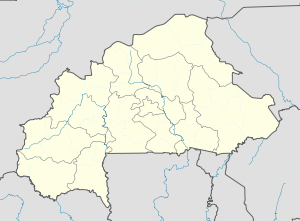Ouahigouya
| Ouahigouya | |
|---|---|
 |
|
| Location within Burkina Faso, French West Africa | |
| Coordinates: 13°35′N 2°25′W / 13.583°N 2.417°W | |
| Country |
|
| Province | Nord Region |
| Province | Yatenga Province |
| Founded | 1757 |
| Elevation | 315 m (1,033 ft) |
| Population (2012) | |
| • Total | 86,569 |
| Time zone | GMT (UTC+0) |
Ouahigouya is a relatively notable town in northern Burkina Faso. It is the capital of the Yatenga Province and one of its subdivisions the Ouahigouya Department. It is also the biggest town in the Nord Region. It is the third largest city in the country with a population of 122,677. It is situated 182 kilometres (113 mi) north-west of Ouagadougou.
The city itself has a stadium, a private non-profit Paediatric Hospital with 36 beds for giving birth and 24 beds for children suffering of severe malnutrition, a post office with internet access and at least one Ecobank bank branch.
The city was founded in 1757 as the capital of Yatenga one of a number of Mossi Kingdoms. It was destroyed in 1825 by the French colonial government and it was repeatedly attacked from the 1870s to the 1890s, until the French began rebuilding it around a fort from 1896. The city still bears testimony to its role as capital of the Yatenga Kingdom in its name, the meaning of which is come and prostrate yourselves.
In the Christmas War of 1985, the city's marketplace was bombed by Malian forces, almost 100 people being killed.
Mainly of an agriculturally based economy, Ouahigouya also has some commerce and craft industry. The two dams just north and west of the town permit it to pursue some vegetable planting aided by irrigation, such as tomatoes, carrots, onions and mainly potatoes. But as a whole both the region and the city are heavily dependent on rainfall and it is according to it that the population's well being mostly depends on. Millet and sorghum though are the basis of the local diet, much like the surrounding regions.
The small craft industry here is mainly focused on leather and tanneries. The little industry in the region is mostly geared towards gold prospecting, and is carried out by a large company. In terms of commerce, the city takes advantage of its relative ease of access to the country's capital, Ouagadougou, to buy manufactured products and resell to the local economy. This is greatly facilitated by the asphalted road linking the two cities.
...
Wikipedia

